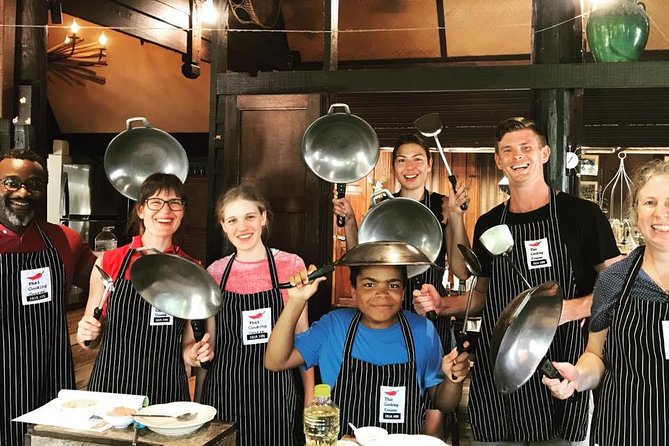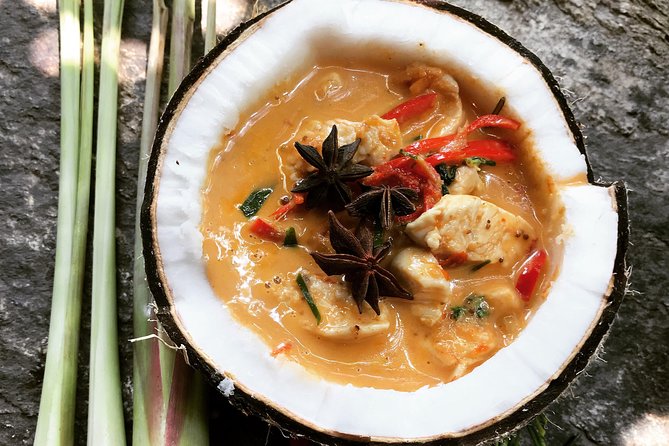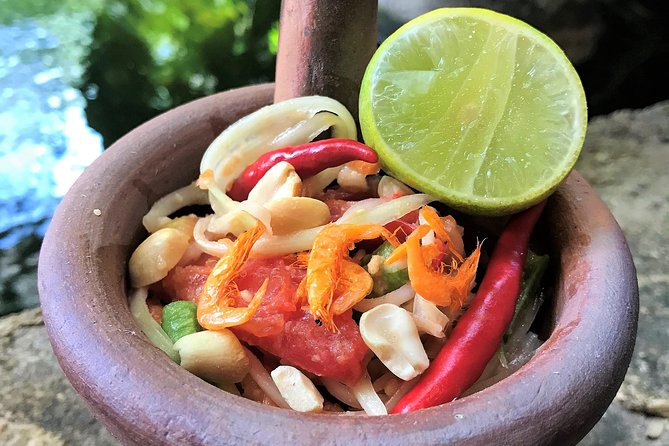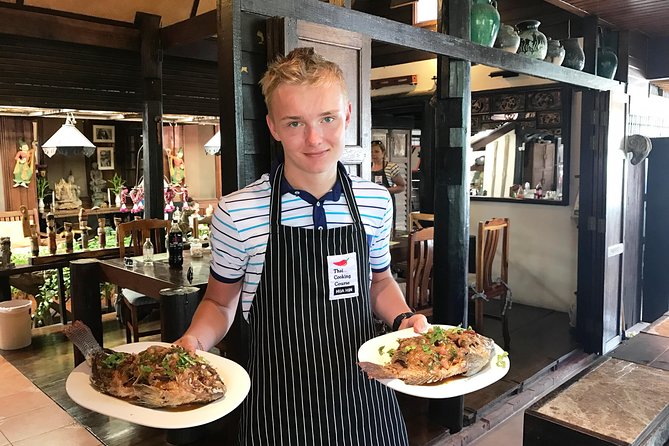Enjoy the rich culinary traditions of Thailand with Introduction Thai Kitchen’s Menu Set 2. This hands-on experience takes you on a journey through the vibrant Chatchai Market, where you’ll learn to craft an authentic red curry paste. From there, you’ll dive into preparing iconic Thai dishes like the savory Gaeng Ped Moo and the sweet Khao Niaow Ma Muang. With each step, you’ll uncover the flavors and techniques that make Thai cuisine so captivating. But the real question is, are you ready to embark on this culinary adventure?
Key Points

- Explore a traditional Thai teak house setting with antique Asian furnishings and a tranquil koi pond, providing an immersive cultural experience.
- Visit the 100-year-old Chatchai Market to learn about traditional Thai ingredients and their uses through a guided tour.
- Prepare an authentic red curry paste using a mortar and pestle, a fundamental component for Thai dishes.
- Cook a Thai red curry with pork (Gaeng Ped Moo) and a chicken and cashew stir-fry (Gai Pad Med Mamuang).
- Craft a refreshing green papaya salad (Som Tam) and a sweet sticky rice with mango dessert (Khao Niaow Ma Muang).
Exploring the Thai Teak House
The traditional teak house, set amidst landscaped grounds and a tranquil koi pond, provides an authentic backdrop for the Thai cooking class.
Antique Asian furnishings and decor create an immersive cultural experience as students learn to prepare classic Thai dishes.
The spacious kitchen is equipped with all the necessary tools, allowing participants to fully engage in the cooking process.
Outside, the lush greenery and serene water feature offer a calming ambiance, transporting guests away from the bustling streets of Hua Hin.
This historic teak house serves as the perfect setting to discover the rich culinary traditions of Thailand in an intimate, hands-on learning environment.
You can also read our reviews of more tours and experiences in Hua Hin.
Visiting the Chatchai Market

Before preparing the Thai dishes, participants visit the nearby 100-year-old Chatchai Market to gather the necessary ingredients.
This bustling outdoor market offers a glimpse into the daily life of the local community. Participants browse the vibrant stalls, selecting fresh produce, herbs, and spices required for the recipes.
The sights, sounds, and aromas of the market heighten the senses and set the stage for the cooking experience. Guided by the instructor, participants navigate the market, learning about traditional ingredients and their culinary uses.
This immersive introduction to Thai cuisine lays the foundation for the hands-on cooking lesson that awaits back at the traditional teak house.
Preparing the Red Curry Paste

After gathering the essential ingredients at the Chatchai Market, participants begin preparing the foundation of Thai cuisine – the red curry paste.
Using a mortar and pestle, they grind together an aromatic blend of dried red chilies, lemongrass, galangal, shallots, garlic, and spices. The fragrant mixture comes together through a rhythmic pounding, releasing its intense flavors and setting the stage for the rest of the dishes.
With focus and care, they expertly blend the ingredients until a smooth, vibrant paste is formed. This homemade red curry paste will be the key component in the authentic Thai red curry with pork that they’ll prepare next.
The group works together, learning traditional techniques and appreciating the importance of this fundamental ingredient.
Cooking Gaeng Ped Moo

With the red curry paste prepared, participants next turn their attention to cooking Gaeng Ped Moo, the classic Thai red curry with pork. They add the fragrant paste to a wok, simmering it with coconut milk, fish sauce, palm sugar, and tender chunks of pork until the flavors meld together in a rich, aromatic curry. The sizzling of the pan and the enticing scents fill the air as they carefully monitor the dish, adjusting the seasonings to achieve the perfect balance of spicy, sweet, and savory. This time-honored recipe is an essential part of Thai culinary tradition, and the class eagerly anticipates bringing these authentic flavors to life.
| Ingredient | Amount |
|---|---|
| Red curry paste | 3 tbsp |
| Coconut milk | 1 cup |
| Fish sauce | 2 tbsp |
| Palm sugar | 1 tbsp |
| Pork, cubed | 300g |
Stir-Frying Gai Pad Med Mamuang

The class now turns their attention to stir-frying Gai Pad Med Mamuang, or Chicken with Cashew Nuts, an aromatic and crunchy Thai dish.
The instructor demonstrates how to prepare the ingredients – sliced chicken breast, onions, garlic, bell peppers, and roasted cashews.
She stir-fries the chicken in a wok, adding fish sauce, soy sauce, and a pinch of sugar to build the flavors.
The vegetables are added next, and the dish is tossed quickly to ensure even cooking.
Finally, the roasted cashews are folded in, providing a satisfying crunch.
The students eagerly watch, taking notes on the technique, before enjoying the flavorful stir-fry alongside the other dishes they’ve prepared.
- Hua Hin: Sam Roi Yod and Praya Nakhon Cave Group Tour
- Bangkok Hotel: Transfer To/From Hua Hin Hotel Transfer
- Hua Hin: The Real Jing Jing Thai Food Tour
- Hua Hin: Family Thai Food Tour With Local Guide
- Elephant and Wildlife Watching in Kuiburi National Park – Private Afternoon Tour
- Sunset Local Eats Food Tour in Hua Hin
Crafting the Som Tam
Crafting the Som Tam, a zesty Thai papaya salad, begins with shredding fresh green papaya into long, thin strands using a specialized grater or julienne peeler. The instructor demonstrates the proper technique, emphasizing the importance of achieving the right texture and consistency for the dish.
Next, the class adds tangy lime juice, fish sauce, chilies, peanuts, and other aromatic ingredients, then gently mixes and pounds the salad with a traditional mortar and pestle.
The result is a vibrant, flavor-packed dish that beautifully balances sweet, sour, spicy, and salty notes. The students eagerly taste their creations, impressed by the complexity of flavors and textures in this quintessential Thai street food.
Savoring Khao Niaow Ma Muang
Next, students eagerly anticipate the sweet finale – Khao Niaow Ma Muang, or mango with sticky rice. The instructor meticulously demonstrates the preparation of this classic Thai dessert, beginning with the sticky rice.
| Ingredient | Preparation |
|---|---|
| Sticky Rice | Soak in water for 4-6 hours, then steam until tender. |
| Coconut Milk | Combine with sugar and salt, then heat gently. |
| Ripe Mango | Slice into bite-sized pieces. |
The sticky rice is infused with the rich coconut milk mixture, creating a delightfully creamy and sweet foundation. The fresh, juicy mango slices provide a perfect contrast, resulting in a harmonious blend of flavors and textures that exemplifies the essence of Thai desserts.
Receiving the Completion Certificate
At the end of the Thai cooking class, participants proudly receive a certificate of completion, commemorating their successful culinary journey through the rich traditions of Thai cuisine.
This certificate, adorned with vibrant Thai motifs, serves as a tangible reminder of the skills they’ve acquired and the flavors they’ve mastered. The instructors present each participant with their personalized certificate, acknowledging their dedication and hard work throughout the class.
Holding this certificate, attendees feel a sense of accomplishment, knowing they’ve not only learned to prepare authentic Thai dishes but also gained a deeper appreciation for the country’s culinary heritage. This certificate is a cherished memento, a symbol of the unique experience they’ve had in the traditional teak house kitchen.
Frequently Asked Questions
Is There a Vegetarian/Vegan Menu Option Available?
Yes, there is a vegetarian/vegan menu option available. The dishes can be prepared without meat, and vegetarian/vegan substitutes can be used for certain ingredients upon request.
Can I Bring My Own Alcoholic Beverages to the Class?
No, bringing your own alcoholic beverages is not permitted. The class provides non-alcoholic beverages like tea, coffee, and a welcome herbal drink. Participants should refrain from bringing outside alcoholic drinks to the traditional Thai cooking class.
Is This Cooking Class Suitable for Children Under 12 Years Old?
Children under 12 are welcome but must be supervised by an adult. The hands-on cooking experience may not be suitable for very young children, so parental discretion is advised. The class has a maximum group size of 15 travelers.
Do I Need to Bring Any Cooking Utensils or Equipment?
No, participants don’t need to bring any cooking utensils or equipment. The class provides all necessary tools and ingredients for preparing the dishes. Travelers just need to show up ready to learn and cook some traditional Thai cuisine.
Is It Possible to Take the Recipes Home in Electronic Format?
Yes, it’s possible to take the recipes home in electronic format. The cooking class includes a recipe booklet, and the instructor may also share the recipes electronically with participants upon request.
Recap
Participants enjoy Thailand’s culinary traditions, starting at the vibrant Chatchai Market.
They learn to prepare authentic red curry paste, then craft iconic dishes like red curry with pork, stir-fried chicken with cashews, and spicy green papaya salad.
The experience culminates in the creation of the sweet and creamy mango with sticky rice, and participants receive a personalized completion certificate.
More Tour Reviews in Hua Hin
Not for you? Here's more nearby things to do in Hua Hin we have reviewed
- HUA HIN : Koh Talu Snorkeling With Lunch (Private 4 Pax Up)
- HUA HIN : Pala U Waterfall Natural Tour (private for 2paxup)
- Hua Hin Unlocked: An 8-Hour Customized Journey
- HUA HIN : Phraya Nakhon Cave ( Private 2 or 3 Pax )
- Hua Hin: Vana Nava Waterpark Ticket
- Hua Hin: Teach Muay Thaï Group Sessions
- 25 Best Tours In Hua Hin
- 4 Best Guided Tours In Hua Hin
- 4 Best National Park Tours In Hua Hin
- 2 Best Shopping Tours In Hua Hin
- Private Bangkok Airport Transfer To/From Hua Hin Hotels
- Stunning Ao Manao Bay & Prachuabkirikhan Private Guided Tour of Hua Hin
